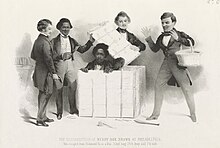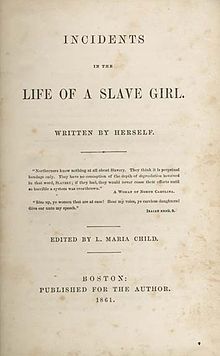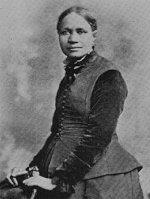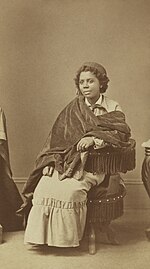The Crafting Freedom Project

The Crafting Freedom Project focuses on the development of lesson plans for teaching about little-known, but significant nineteenth-century African Americans. Our focus is on 3rd-8th grade lesson plans. Phase I of our multi-phase project concerns the development of instructional materials and lessons that feature the following women Freedom Crafters: Frances E. W. Harper, Harriet Ann Jacobs, Elizabeth Keckly, Edmonia Lewis, and Sally Thomas. Phase II. (Spring /Summer 2008) will be expanded to include these freedom crafters: Lunsford Lane, Henry "Box" Brown, and William Henry Singleton. These individuals have received much scholarly attention in recent years and are historically significant, yet remain little known beyond the academy. They—and thousands of other African Americans like them—crafted freedom by purchasing it, through active resistance to slavery, through their art and creative expression, and through their spoken and written words.The purpose of this Wikiversity project is to involve classroom teachers, professional educators, scholars, and other interested parties in the process of creating unique, rich, and innovative curricula for teaching students about the lives of these remarkable Americans. This Wikiversity learning project is being used as a development environment. The lesson plans that emerge from this project will be available on a website for educators, targeted especially to elementary and middle grade teachers.
Laurel C. Sneed
Executive Director of the Crafting Freedom Project
What to contribute
[edit | edit source]Please be sure to read this section and the Posting Your Contribution section before adding your ideas.
- Key Instructional Strategies
A key instructional strategy should be about one paragraph in length. We are seeking high-level instructional strategies for teaching 3rd-8th grade students about the lives of each of five women Freedom Crafters (Frances Ellen Watkins Harper, Harriet Jacobs, Elizabeth Keckly, Edmonia Lewis, and Sally Thomas). We are not seeking step-by-step lesson plans, rather a brief summary of a unique and innovative teaching strategy that might capture the interests of 3-8 grade students.
Contributors should be familiar with at least some of the works (primary sources such as slave narratives, literary works, autobiographies, art pieces, etc.) of the Freedom Crafters before making a contribution. If your key instructional strategy derives from reading or viewing a primary work created by one of the Freedom Crafters or a secondary work related to one of the Freedom Crafters, please be sure to cite the source (including page numbers if applicable). Contributors might also consider the use of material culture in lesson plans on these women. Contributors should feel free to use national social studies or language arts standards for ideas, but are not required to base Key Instructional Strategies on standards. Links to information on the standards can be found below in the external links section. The list below shows the resources that are part of this project:
- The Crafting Freedom Project/Sally Thomas
- The Crafting Freedom Project/Henry Box Brown
- The Crafting Freedom Project/Frances E. W. Harper
- The Crafting Freedom Project/Elizabeth Keckly
- The Crafting Freedom Project/Edmonia Lewis
Posting your contribution
[edit | edit source]Please be sure to read this section and the What to Contribute section before posting your ideas.
Instructions
[edit | edit source]Following these instructions is important in order to maintain a consistent format for the postings.
- Go to the Add Your Ideas section below.
- Click Edit next to the name of the Freedom Crafter for which you wish to make a contribution.
- Be sure to leave existing code and text intact (do not delete anything in the edit window).
- Type
* Key Instructional Strategyon the first line of your entry. - Hit Enter/Return twice to form a blank line after the first line.
- Type your idea in paragraph form below, starting on the third line of your posting.
- You can add Contributed by followed by your name at the end of the paragraph if you wish to do so. Providing your name is not required.
- Click Save page at the bottom of the edit interface after you type in your contribution.
Examples
[edit | edit source]These are examples of how you should post your contributions under Add Your Ideas.
- Key Instructional Strategy

The purpose of this lesson idea is for students to understand that even within an oppressive legal institution, there is the ability to create spaces for freedom which show resilience, power, ingenuity, and determination. Students should discuss the meaning of "Loophole of Retreat" (chapter XXI, Incidents in the Life of a Slave Girl). The teacher should summarize the narrative, then the students read chapter XXI. The students then draw/build "Linda's" retreat. Next, the students work in small groups, then the whole class forms a group to discuss in what way is the space different from a retreat? Think about slavery versus freedom, physical confinement, how "Linda" feels about her confinement? Also think about how the space might be powerful, how it gives access to private information, how "Linda" is able to see her children through the holes to make a parenting decision, how she is able to read and sew and increase her skills and knowledge, and, finally, how she is able to frustrate her master who does not know where she is? Then, the teacher should lead the students back to the first question: how is this space a loophole of retreat for "Linda"? Finally, students should find a current example of a loophole of retreat and explain how they have deduced that it is a loophole of retreat. Contributed by Crafting Freedom Summer Workshop Participant, 2007.
- Key Instructional Strategy
Hand out a page of facts about F. E. W. Harper to including information like: the period in which she lived; published book of poems, "Forest Leaves" when 20 years old; taught at Union Seminary in Wilberforce, Ohio; popular anti-slavery lecturer; etc. The list omits her race (black) and her gender. After students review the fact sheet, ask them to draw a picture of this nineteenth-century figure and/or write a paragraph describing what they think this person looked like. Share the drawings/paragraphs with group. This strategy introduces Harper but it also may "catch" students in the act of stereotyping by gender and/or race. Ask students what fact/s on the list led them to think this person was a man/woman, black/white, or whatever? Why did they "equate" a particular fact with a race or gender? After discussing drawings/descriptions, show the students an image of Harper. How is it alike/different from the one they drew? Say her full name: "Frances Ellen Watkins Harper". Define stereotyping and continue to find ways for students to reflect on IF they "stereotyped" Harper and "why" their thinking was affected by racial/gender stereotypes. Guide discussion to an awareness that seeing people in terms of a racial or gender and racial stereotypes LIMIT their human potential. Transition to how Frances Ellen Watkins Harper was stereotyped in her own lifetime, i.e. some whites believed Harper to be a black man dressed as a woman or a white woman painted black. Why did they think this? Ask what are some race/gender stereotypes that persist today? Have you ever been stereotyped? How did that make you feel? Have you stereotyped someone else? Motivate students to self-examine when they catch themselves in the act of stereotyping themselves or others. Originally developed by a teacher-mentor with the Thomas Day Education project for a lesson entitled "Who Was Thomas Day?" in the Thomas Day Furniture Kit.
Add your ideas
[edit | edit source]Please be sure to read the What to Contribute and Posting Your Contribution sections above before adding your ideas.
- Key Instructional Strategy

Have students read poems selected from "Forest Leaves". Ask them to describe who they think the writer of the poems looked like and why. Introduce Frances E. W. Harper and describe her orphan slave background. Stress the fact of her not knowing her mother and father. Then ask students to write poems in the sentiment as if they were slave orphans. This will help the students connect to the feelings of what is was like to be a slave and also introduce the significance of poetry as a powerful tool to overcome oppression. Other examples of historical poets/poems can be referenced to support this theme to include present day poets/rappers. Contributed by Stephanie Perry.
- Key Instructional Strategy

The objective of this lesson is for students to understand the process used by slaveowners to locate and have runaway slaves returned to the condition of slavery. The teacher should have students read chapter XVII of Harriet Jacobs' narrative, "Incidents In The Life Of A Slave Girl." Discuss Linda's flight, and Dr. Flint's reaction to it, including his efforts to locate her. Use the Internet to locate examples of slave runaway posters. Copy and distribute runaway posters to the class. Instruct the students to examine the posters and discuss their findings. Have the students review page 149 of chapter XVII in "Incidents in the Life of A Slave Girl." Instruct the students to create their own runaway advertisement using the information and description of Linda that Dr. Flint uses in his add. Have the students make a sketch of Linda based on Dr. Flint description. Have the students share their posters, then have the posters laminated and display in the classroom. Contributed by Christine Williams.
- Key Instructional Strategy
Have the student read chapter XXII in Harriet Jacobs' narrative, "Incidents In The Life Of A Slave Girl." The teacher should divide the class into four groups. Instruct each group to select someone to act as recorder with the duty of writing for the group, and reporter who will read the groups description to the class. Have each group write a descriptive paragraph using the information in chapter XXII of Jacob's book. Make the following assignments: Group I, Write a description of a Slave's Christmas; Group II, Write a description of the slave children's beliefs about Santa Claus in contrast to Benjamin's ideas about Santa; Group III, use chapter III of Jacob's book to write a description of Hiring Day; and Group IV should write a description of Linda's Christmas. Have each group's reporter read their description to the class and lead the class in a discussion of their topic. Post the descriptions around the classroom. Contributed by Christine Williams.
- Key Instructional Strategy

This idea could be used with all of the target grade levels. Edmonia Lewis was highly successful in manipulating her image to secure support from her patrons and the larger community. She created an image of herself as “the Indian maiden, who decided that she, too, could make a stone man.” Examine her strategies in presenting herself to the art world and the larger community as an example of what we now call branding. This is the idea of establishing one’s image in order to sell a product. Compare her successful attempts to set herself apart from other female artists of her time to those of a modern artist. A performer like Beyonce, who is highly successful in creating an image which allows her to succeed in many areas, may be a good modern parallel. Male examples of skillful branding include 50 Cent and Sean Combs. Contributed by Beverly J. McNeill.
- Key Instructional Strategy
It was very difficult for women to be recognized and appreciated for their talent as visual artists in the 19th century. It was especially difficult for African American women artists to be recognized and accepted. This lesson provides students an introduction to the sculptor, Edmonia Lewis, and places her in context with several other 19th century American women artists. William Hayes Ackland, the collector and museum benefactor, once saw Lewis dusting off one of her masterpieces, Cleopatra, and described her in his memoir as looking like a "Southern cook" (Later crossed out and replaced with "housemaid"). This stereotypical and demeening view of black women is illustrative of the kind racial and gender bias Lewis had to contend with in America, which contributed to her expatriation to Europe where she lived most of her life. Lewis' achievements as an artist are all the more extraordinary given the extraordinary social obstacles she was up against.
- Key Instructional Strategy
Sally Thomas and other enslaved women and men developed strong character, self-confidence and keen business as well as "life" management skills in spite of their enslavement. One important skill Sally Thomas had was the ability to make wise choices, aka good decisions. For her, this was a question of survival. Review characteristics of "good life decisions" with students. Then have the students read or read to the students an overview of Sally Thomas life story with quotes from the Biography on her life (Schweninger/Franklin). Focus on the decisions she made or others made that affected her path in life. Have students identify decisions that were out of her control, and those that were in her control. One decision she made was to acquire the freedom of her sons before she tried to purchase her own freedom. Ask students what they think about this (and other hard decisions) she made. What would they have done if in her shoes?. Today there are many opportunities for citizens to pursue life goals, but there will always be obstacles of all kinds to overcome. People in our society who do not have many resources -economic, family support, educational , etc.- are often faced with tough decisions and feel, because of their limited resources, that the situation is hopeless. Sally Thomas was one of millions of African Americans who creatively 'made a way where there was no way', and it took excellent decision making skills to find a path around the enormous barriers she confronted. Students will learn to use good decision making skills by analyzing the "lived experience" and decisions of Sally Thomas.
- Key Instructional Strategy
The "I can't/I can game" The goal of this game is to have students identify all the limitations that Sally Thomas had working against attaining her childrens' freedom. Then identify all the actions/thoughts she may have used to overcome them. Then the teacher will ask the students to identify three dreams/goals they would like to achieve and the reasons why they think they cannot achieve them. From provided materials, the students can match up similar limitations that the historical figure(Sally Thomas) had and incorporate these powerful thoughts/attitudes/actions into their particular experiences. This exercise will give teachers a deeper insight and a better understanding of resistance they may be getting from their students. This exercise also will allow students to connect early with the idea that with some thought and creativity they have what it takes inside themselves to realize their dreams. Contributed by Stephanie Perry.
- Key Instructional Strategy
How does a typical day in Sally Thomas' life reflect both her freedom and the limits to her freedom? Using the Franklin/Schweninger book, assign students to read the section entitled "Virtual Freedom" pages 14-16. Assign them to write answers to the questions: 1) Is Sally Thomas a slave or a free woman? 2) Where does she work? 3) What does she do on a daily basis? 4) Why are her services valuable to the residents of Nashville? 5) How does her owner treat her? 6) What does Sally want to do with money she earns? These can be framed in a worksheet, and worked on in teams (or not) and then provide the basis for a class discussion about the different variations of slavery and freedom that defined the antebellum South.
- Key Instructional Strategy

The purpose is to use 19th century images of American women from all walks of life to motivate students to analyze "dress" and "fashion" in the 19th century as a reflection of social, cultural, political, economic, and artistic forces of the era. It will also introduce Keckly, who became a highly sought after fashion designer to the most powerful women of her era, including Mary Todd Lincoln. Students see many pictures from publications like Harper's Weekly as well as Gody's Lady Book and compare and contrast the fashionsthey see. Several Keckly designs for Mrs. Lincoln's dresses will be provided. Students will notice when comparing images that poor working women wear garments that are simply constructed in coarse fabrics like "homespun" and are practical for work, i.e. cooking, cleaning, etc. In contrast, the garments worn by women with status and power like Mary Todd Lincoln involve so much fabric and are so complexly constructed that doing any kind of physical labor in the garment was out of the question, In fact it took the labor of another person merely to "dress" a woman in the gown. What garments can and cannot tell us about the woman who's wearing the garment will be discussed. Students learn how Keckly acquired sewing skill from her mother, purchased her freedom with her needle arts skills, and continued in this trade until late in life. Mid 19th century paper doll clothing based on Paris fashions as well as Keckly designs will be providedfor students to "cut-out" and "play with." These were originally used to "demonstrate" what a fashion design looked like so women could show the miniature design to a seamstress or try to sew it with her own skills. Students use their favorite Keckly fashion design as an inspiration for a miniature drawing of their own original design of a formal gown for the 21st century. They will describe in writing why they chose the design and how the 19th century dress design informed/inspired their creation. Modified from a contribution of a 2005 CF participant and also based on the lesson in the Thomas Day kit, "You are the Furniture Designer" created by Rodney Berry.
- Key Instructional Strategy
Goal: The student will view Keckly in terms of her role in the transition of sewing technology. This fits an NC Standard course of Study objective about ways that technology changes have Affected life and the economy of NC. Elizabeth Keckly worked in a period of great technological change. Her own career spanned the change from hand sewing to use of the first sewing machines. Students should do research on hand sewing, using material from "Stitched from the Soul". They should then investigate the invention of the sewing machine, how it was used in the early construction of women's clothing. And how it reduced the effort of making clothing. Contributed by Beverly McNeill.
- Key Instructional Strategy
A letter appears in Keckly's narrative that is one she wrote to her mother while she was enslaved as a young teen in Hillsborough. The letter is very rich with descriptions of Keckly's daily life and provides much insight into the anguish of a young enslaved woman separated from her loved ones and how it felt to be "growing up" enslaved. The lesson focuses on the letter that students either read of have read to them. They are instructed to listen for ONE or TWO words or phrases that grab their attention in the letter. After the teacher goes around the room and asks students what word or phrase they related to in the narrative, the reasons the words or phrases grabbed their attention is discussed. Next students discuss messages that were overt - spoken directly - and messages that were - unspoken- or indirect, like when she asks that a package be sent to another person's home where she can pick it up. Having discussed the text and all of its subtleties, students will have an option of further experiencing the text by: writing a "fictional" response to Harriet's letter to her mother as if they are the Mother responding to the points in the daughter's letter; writing a poem that deploys some of keckly's own words and phrases such as the metaphor "three cornered box" ; write a short scene for a role-play based on an experience Keckly describes in the letter.
- Key Instructional Strategy
Singleton, when enslaved as a youth, ran away from his masters and hid from patrollers many times before he reached maturity and was finally able to claim his freedom by running away to union forces in NC during the Civil War. Students learn that resisting enslavement by "running away" was common place and become familiar with the different types of fugitive behavior slaves engaged in. Although brutally punished for running away, many enslaved people, like Singleton, were not deterred from their quest to attain freedom by the dire consequences of such overt resistance. This lesson focuses on the segment of Singleton's narrative that explains how at the age of 7, he travelled a distance of over six hundred miles running away from a master in Atlanta back to his mother in New Bern, North Carolina by posing as the slave of a white woman. He was also helped by black adults. Students learn about overt and covet resistance; the fact that young men - even children - were the most frequent fugitives; and can recall incidents of success and failure. They will understand that MOST attempts were futile and will be able to explain why.
- Key Instructional Strategy
Singleton was one of many African Americans who joined the Union army during the Civil War once Abraham Lincoln lifted the ban on African American service. Through the lens of Singleton's military experiences students will learn about African American soldiers during the Civil War: their motives for service; their varied experiences; and their treatment by their peers and superiors. Singleton's military experiences will be the major focus within the larger context of black miltiary involvement in the Civil War.
- Key Instructional Strategy

"Enslaved Entrepreneur," Lunsford Lane was a very significant 19th century figure because he provides a rare and detailed first-hand account of how an enslaved individual could manage to become an independent entrepreneur and business owner while still a slave, even though all Southern states had laws against slaves starting their own independent businesses. In Lane’s case these laws were ignored. Using his narrative as a reference the lesson will discuss Lane's speciality product, a flavored tobacco, why it was successful, and will explain why Lane is considered an "entrepreneur." Students will analyze the attributes of Lane, the business man, that made him successful citing examples from his narrative. Student's will conduct an oral history with a successful business person today and will write a paper comparing and contrasting the qualities successful business people today say are important NOW vs. the characteristics that Lane describes that helped him to be successful in business while enslaved. Extensions include using a standard business plan model to describe the various components of Lane's tobaccco business; developing a business plan for one's own business idea.
- Key Instructional Strategy
Henry "Box" Brown was a 19th century Virginia slave who escaped to freedom by arranging to have himself mailed to Philadelphia abolitionists in a dry goods container.
External links
[edit | edit source]- Schomburg Center for Research in Black Culture
- Documenting the American South
- Incidents in the Life of a Slave Girl by Harriet Jacobs
- Women in History: Elizabeth Keckly
- Patches from the Past: Elizabeth Keckly
- Women in History: Edmonia Lewis
- Artcyclopedia: Edmonia Lewis
- National History Standards
- National Language Arts Standards
